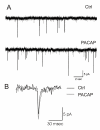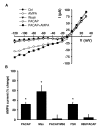Regulation of glutamatergic signalling by PACAP in the mammalian suprachiasmatic nucleus
- PMID: 16483357
- PMCID: PMC1388226
- DOI: 10.1186/1471-2202-7-15
Regulation of glutamatergic signalling by PACAP in the mammalian suprachiasmatic nucleus
Abstract
Background: Previous studies indicate that light information reaches the suprachiasmatic nucleus (SCN) through a subpopulation of retinal ganglion cells that contain both glutamate and pituitary adenylyl cyclase activating peptide (PACAP). While the role of glutamate in this pathway has been well studied, the involvement of PACAP and its receptors are only beginning to be understood. Speculating that PACAP may function to modulate how neurons in the suprachiasmatic nucleus respond to glutamate, we used electrophysiological and calcium imaging tools to examine possible cellular interactions between these co-transmitters.
Results: Exogenous application of PACAP increased both the amplitude and frequency of spontaneous excitatory postsynaptic currents recorded from SCN neurons in a mouse brain slice preparation. PACAP also increased the magnitude of AMPA-evoked currents through a mechanism mediated by PAC1 receptors and the adenylyl cyclase-signalling cascade. This enhancement of excitatory currents was not limited to those evoked by AMPA as the magnitude of NMDA currents were also enhanced by application of PACAP. Furthermore, PACAP enhanced AMPA and NMDA evoked calcium transients while PACAP alone produced very little change in resting calcium in most mouse SCN neurons. Finally, in rat SCN neurons, exogenous PACAP enhanced AMPA evoked currents and calcium transients as well evoked robust calcium transients on its own.
Conclusion: The results reported here show that PACAP is a potent modulator of glutamatergic signalling within the SCN in the early night.
Figures





Similar articles
-
The pituitary adenylate cyclase-activating polypeptide modulates glutamatergic calcium signalling: investigations on rat suprachiasmatic nucleus neurons.J Neurochem. 2001 Oct;79(1):161-71. doi: 10.1046/j.1471-4159.2001.00553.x. J Neurochem. 2001. PMID: 11595768
-
Modulation of AMPA receptor-mediated ion current by pituitary adenylate cyclase-activating polypeptide (PACAP) in CA1 pyramidal neurons from rat hippocampus.Hippocampus. 2009 Jan;19(1):99-109. doi: 10.1002/hipo.20488. Hippocampus. 2009. PMID: 18727050
-
Excitatory mechanisms in the suprachiasmatic nucleus: the role of AMPA/KA glutamate receptors.J Neurophysiol. 2002 Aug;88(2):817-28. doi: 10.1152/jn.2002.88.2.817. J Neurophysiol. 2002. PMID: 12163533 Free PMC article.
-
What really happens in the SCN at night.J Physiol. 2001 Apr 1;532(Pt 1):1. doi: 10.1111/j.1469-7793.2001.0001g.x. J Physiol. 2001. PMID: 11283220 Free PMC article. Review. No abstract available.
-
Pictorial review of glutamate excitotoxicity: fundamental concepts for neuroimaging.AJNR Am J Neuroradiol. 2001 Nov-Dec;22(10):1813-24. AJNR Am J Neuroradiol. 2001. PMID: 11733308 Free PMC article. Review. No abstract available.
Cited by
-
Vasoactive intestinal peptide produces long-lasting changes in neural activity in the suprachiasmatic nucleus.J Neurophysiol. 2013 Sep;110(5):1097-106. doi: 10.1152/jn.00114.2013. Epub 2013 Jun 5. J Neurophysiol. 2013. PMID: 23741043 Free PMC article.
-
Linking neural activity and molecular oscillations in the SCN.Nat Rev Neurosci. 2011 Sep 2;12(10):553-69. doi: 10.1038/nrn3086. Nat Rev Neurosci. 2011. PMID: 21886186 Free PMC article. Review.
-
Brain-derived neurotrophic factor regulation of N-methyl-D-aspartate receptor-mediated synaptic currents in suprachiasmatic nucleus neurons.J Neurosci Res. 2006 Nov 15;84(7):1512-20. doi: 10.1002/jnr.21063. J Neurosci Res. 2006. PMID: 16983663 Free PMC article.
-
Circadian entrainment and its role in depression: a mechanistic review.J Neural Transm (Vienna). 2012 Oct;119(10):1085-96. doi: 10.1007/s00702-012-0858-z. Epub 2012 Jul 14. J Neural Transm (Vienna). 2012. PMID: 22798027 Review.
-
Inhibitory responses to retinohypothalamic tract stimulation in the circadian clock of the diurnal rodent Rhabdomys pumilio.FASEB J. 2022 Aug;36(8):e22415. doi: 10.1096/fj.202200477R. FASEB J. 2022. PMID: 35867045 Free PMC article.
References
-
- Colwell CS, Menaker M. Excitatory Amino Acids: Their Role in Neuroendocrine Function. CRC Press; 1996. Regulation of circadian rhytms by excitatory amino acids; pp. 223–252.
Publication types
MeSH terms
Substances
Grants and funding
LinkOut - more resources
Full Text Sources
Molecular Biology Databases

